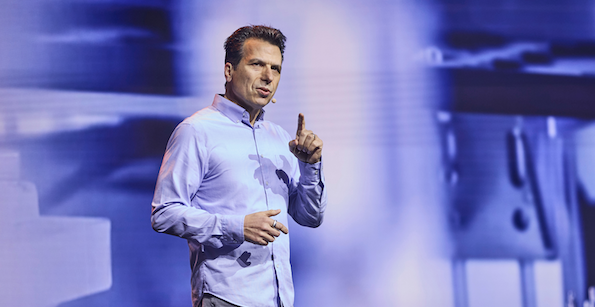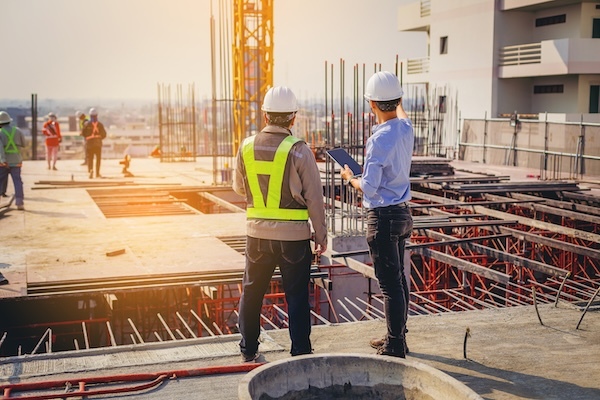
After years of watching other nations build and operate high-speed rail systems, the United States is making tangible progress in constructing a new generation of passenger rail lines. With an upswing in funding in recent years, construction is proceeding on HSR in the western U.S., and other projects are progressing through planning stages.
The new HSR projects are massive, complex endeavors, so they are often accompanied by myriad design, construction, and political challenges. To address these challenges and keep the projects moving, technological tools are playing key roles. Industry experts are also hoping technology can help address a workforce shortage in the fledgling HSR community — a shortage even more pronounced than the overall talent shortage experienced throughout the AEC industry.
A Eurostar train at St. Pancras Station in London awaits its maiden run on the High Speed 1 rail line. Image source: Bechtel. Click image to enlarge.
California Digs In
The most visible HSR progress in the U.S. is occurring in California, where the California High-Speed Rail Authority is building a 494-mile system between San Francisco and Los Angeles. Construction is underway on a 119-mile segment in California’s Central Valley, with plans to extend that to a 171-mile stretch and begin passenger service between 2030 and 2033, according to Kyle Simerly, California High-Speed Rail Authority information officer.
Construction is progressing on a California High-Speed Rail overpass in Fresno County. Image source: California High-Speed Rail Authority. Click image to enlarge.
Looking ahead, the Authority has obtained environmental clearance to build 463 miles of the system as funding becomes available. The Authority also expects to award a contract by the end of the year to build the first system trainsets. “This is an exciting time for California high-speed rail,” Simerly said.
One of the primary challenges the Authority faces is the ongoing quest for funding, which is being addressed in a “building block fashion,” according to Simerly. In 2008, California voters passed Proposition 1A that provided nearly $10-billion in general obligation bonds. Over the last few years, the Authority has received more than $3.3-billion in federal funding, most of it from the Federal-State Partnership for Intercity Passenger Rail Program. The Authority has also identified future grant opportunities of more than $75-billion via the Bipartisan Infrastructure Law (BIL). The total system cost is estimated to range from $88- to $128-billion, according to a 2023 Authority report.
Based on stipulations of Proposition 1A, a trip from San Francisco to Los Angeles must take less than 3 hours. This requires trains to attain speeds of 220-mph, requiring flatter grades and smoother horizontal geometry than freight trains and light rail transit systems. While definitions of high-speed rail vary, the Paris-based International Union of Railways (UIC) considers a commercial speed of 250 km per hour (155 mph) to be the principal criterion for the definition of HSR.
California High-Speed Rail Authority trains are being designed to attain speeds of 220 mph. Image source: California High-Speed Rail Authority. Click image to enlarge.
To keep the public informed on the project status, CHSR planners and designers have used a variety of technologies to produce models, renderings, and videos. Deutsche Bahn, the Authority’s Early Train Operator, has used proprietary CAD software to prepare renderings of preliminary trainset interiors.
Renderings of preliminary trainset interiors were prepared with proprietary CAD software by Deutsche Bahn, the Authority’s Early Train Operator. Image source: California High-Speed Rail Authority. Click image to enlarge.
Designers have also used OpenRoads ConceptStation from Bentley Systems, Inc. to develop 3D designs of rail lines and other facilities. The tool helps teams visualize how different options impact the various designs and surrounding areas. In the near future, the Authority plans to use virtual reality to “bring people across time and space to visit massive construction projects they may have never been able to visit in person,” said Simerly.
Other U.S. Projects
Other HSR projects are also moving forward in the U.S. Brightline West, a line connecting Las Vegas and Southern California, recently broke ground and is expected to begin service in 2028. The 218-mile line will operate at speeds up to 200 mph, carrying passengers from Las Vegas to Rancho Cucamonga in 2 hours and 10 minutes, twice as fast as the normal drive time.
The Brightline West project is being led by a private group that also helped build Brightline Florida, which began service in 2018. While technically not a high-speed rail line according to UIC criteria, the line provides a 125-mph dedicated line between Tampa, Orlando, and Cocoa, and a 110-mph line between Cocoa and Miami that was built in an existing freight railroad corridor.
In Texas, Amtrak and Texas Central Partners have proposed a 240-mile high-speed line that would move passengers between Dallas and Houston in less than 90 minutes. Capable of operating at speeds in excess of 200 mph, the system would use Japanese technology featuring rolling stock similar to bullet trains running between Tokyo and Osaka, Japan.
The Texas project is anticipated to “stimulate economic development, generate tens of thousands of jobs each year during construction, and infuse billions of dollars of tax revenue into the state and local communities,” said Chris Enoch, head of the global rail sector for Bechtel, an engineering, construction, and project management contractor that is part of a consortium that has provided conceptual design, planning, and procurement services on behalf of Texas Central. Amtrak recently received a $63.9-million grant from the Federal Railroad Administration for project planning activities.
Other U.S. corridors being studied for HSR include spokes from Chicago to other major midwestern cities, as well as routes in the northwestern, southeastern, and northeastern U.S. “Any region that has high levels of congestion and high levels of flights between major cities is a potential candidate for this to be successful,” said Andy Kunz, president and CEO of the U.S. High Speed Rail Association, a Washington, D.C.-based advocacy organization and trade association.
Industry Challenges
Along with the uptick in HSR activity, several key challenges need to be addressed for HSR to succeed in the U.S., according to industry experts. In a report entitled “How to Improve Domestic High-Speed Rail Project Delivery,” a team from the Marron Institute of Urban Management at New York University identified five areas needing attention: 1) increased federal direction and leadership; 2) standardization of design criteria; 3) stronger education to develop a qualified workforce; 4) additional project management and procurement capacity at the project sponsor level; and 5) improved permitting and agreements processes that enable project sponsors to better define and plan their projects.
“[Regarding standardization of design criteria,] interoperability should be of paramount importance,” said Eric Goldwyn, a co-author of the report and program director and clinical assistant professor in the Transportation and Land-Use program at the NYU Marron Institute. “Standardization produces benefits in scale, cost, and competitiveness,” he said. As an example, he noted that different railhead cross sections are being considered for various U.S. projects, which could prevent project integration.
Cross sections of American, European, and Japanese rail, along with composite of all three overlaid, show how different standards could prevent integration of multiple HSR projects. Image source: NYU Marron Institute. Click image to enlarge.
Additional federal leadership is needed to develop master railway plans at the national level, similar those developed for highways, noted Rick Harnish, executive director at the High Speed Rail Alliance, a Chicago-based advocacy group focused on HSR in the Chicago area. “[For lines that cross state boundaries,] this is interstate commerce, which makes it a federal responsibility,” he said.
The size and complexity of HSR requires cooperation from a wide variety of stakeholders at the public and private level. “HSR projects are among the biggest, most time-consuming, expensive, and political of all infrastructure developments,” said John Barker, director of global transit, major projects, and high speed rail at AECOM, a U.S.-based infrastructure consultant whose HSR work spans across five continents. “Development and delivery must be sustained through both economic and political cycles,” Barker noted.
Technical criteria and standards for HSR infrastructure and systems are more exacting than for conventional rail systems, adding to the challenge, Barker noted. In addition to requiring smoother geometric alignments that enable higher speeds, he cited the need for more bridges to eliminate at-grade railroad crossings, longer bridges and tunnels, additional noise mitigation in populated areas, and special trackwork to allow trains to cross other tracks at higher speeds.
In addition to addressing technical criteria, HSR teams face challenges in gaining public acceptance of HSR. “Addressing these challenges requires thoughtful and caring public engagement and maintaining flexibility while defining alternative options to optimize value,” said Bechtel’s Enoch. “It has to be a two-way conversation: working closely with communities to help mitigate disruption during delivery, as well as ensuring the best possible outcome to serve them well for generations to come.” In addition to work on the Texas HSR project, Bechtel has provided services on HSR projects in the United Kingdom, Taiwan, and Saudi Arabia.
Technology Plays Role
Enoch noted that technology can “foster greater collaboration, integration, and transparency amongst all project stakeholders – ultimately improving the likelihood of successful project delivery.” He cited the use of BIM, digital twins, automation, and a controlled common data environment, such as Autodesk Construction Cloud, as key technologies contributing to collaborative working environments. He also advocates for simplicity when possible, and not forcing the use of technology. “Just because you can, doesn’t mean you should,” he said.
Opportunities for technology also extend into construction and operation. AECOM’s Barker cited modular construction, pre-fabrication, and economies of scale as efficiency drivers for HSR delivery. Application of 4D and 5D BIM tools enable optimization of construction sequences and enhanced reliability, he noted.
HSR also offers environmental and sustainability benefits. Because HSR systems are generally driven by electric power, increased HSR travel can potentially reduce the use of fossil fuels needed for other forms of transportation. Traction power for HSR train sets is also increasingly being sourced from non-fossil fuel energy sources, noted Barker.
Advanced propulsion systems can further reduce emissions. Maglev propulsion, which is being used in Japan, China, and South Korea, uses electromagnets to levitate rolling stock above the rails, enabling potentially higher speeds than wheel-on-rail technology. Hydrogen-fueled trains have been introduced that emit only water as exhaust, but are currently not viable for high-speed applications, according to Bechtel’s Enoch.
The future looks bright for AEC firms seeking opportunities to work on HSR projects. Additional training, skill development, and awareness of HSR design practices, along with wise use of technology, will be required for the U.S. to catch up with other nations employing HSR. “It’s a brand new industry about to take off in America,” said Kunz. “It’s going to take the whole industry to scale up the expertise to do these projects.”
***
If you have AEC-based ideas or projects you think are newsworthy, drop us a line at editors@cadalyst.com.
Andrew G. Roe
Cadalyst contributing editor Andrew G. Roe is a registered civil engineer and president of AGR Associates. He is author of Using Visual Basic with AutoCAD, published by Autodesk Press. He can be reached at editors@cadalyst.com.
View All Articles










Share This Post